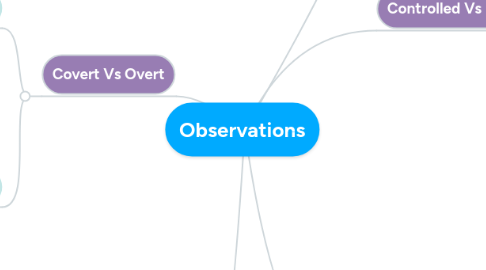
1. Structured Vs Unstructured
1.1. Structured Observation
1.1.1. Put in a structure on their observation to meet their aim and observation system they will use for recording data
1.1.1.1. Allows trends in data to be easily identified
1.1.1.2. Allows comparisons across each observation
1.1.1.3. Collects detailed qualitative data
1.1.1.4. Risk of missing something important as only noting down certain behaviours
1.1.1.4.1. May have very skewed data
1.2. Unstructured Observation
1.2.1. Researcher continuously records and reports on behaviour, noting everything that happens
1.2.1.1. Hard to test for reliability
2. Covert Vs Overt
2.1. Covert Observation
2.1.1. Where the participants know their being observed
2.1.1.1. "Natural" behaviour can be observed
2.1.1.2. higher validity as doesn't disturb normal behaviour
2.1.1.3. No researcher bias or social desirability
2.1.1.4. Raises ethical concerns - consent/privacy
2.1.1.5. If researcher discovered whole research is ruined
2.1.1.6. Hard to sustain over long periods of time
2.2. Overt Observation
2.2.1. Where participant know their being observed
2.2.1.1. Can gain informed consent
2.2.1.2. Easier to record data as can be done openly
2.2.1.3. Demand characteristics
2.2.1.4. Prone to observer effect
3. Designing Observations
3.1. Behavioural Categories
3.1.1. Established categories to observe
3.1.1.1. Necessary in structured observations
3.1.1.2. Provide quantitive data which can be compared, summarised and analysed statistically
3.1.1.3. May restrict view of what is actually happening
3.2. Sampling method
3.2.1. Event sampling
3.2.1.1. when an event is recorded each time it happens
3.2.2. Time Sampling
3.2.2.1. Time point sampling
3.2.2.1.1. The researcher records behaviour at fixed intervals e.g. every 5 seconds over 20 mins
3.2.2.2. Time event sampling
3.2.2.2.1. Where a fixed period of time is is set for observation e.g. first 10 mins of every hour
3.3. Coding frames
3.3.1. The researcher identifies key features of behaviour and code them
4. Controlled Vs Naturalistic
4.1. Controlled Observation
4.1.1. Controls all possible factors which may effect behavior
4.1.1.1. Easily replicated=easy to test for reliability
4.1.1.2. Quantitative data - easy to analyse
4.1.1.3. usually quick so bigger sample
4.1.1.4. Lack ecological validity
4.1.1.5. Demand characteristics
4.1.1.6. Social desirability
4.2. Naturalistic Observation
4.2.1. Carried out in the field
4.2.1.1. Chance to observe natural behavior
4.2.1.2. Observe things cant be manipulated in a lad due to ethical issues e.g. drug effects
4.2.1.3. Supports external and ecological validity
4.2.1.4. People may behave differently if know being watched (social desirability)
4.2.1.5. Different observers may draw different conclusions from same behavior
4.2.1.6. Demand Characteristics
4.2.1.7. No cause and effect
5. Participant Vs Non-participant
5.1. Participant Observation
5.1.1. Observers are (or pretending to be) part of the group being obsevered
5.1.1.1. Good vantage point for observer
5.1.1.2. Get insight into experience and new insights
5.1.1.3. Participants behave as the normally would
5.1.1.4. Researcher bias can change course of events
5.1.1.5. Researcher can get too involved and lose objectivity
5.1.1.6. Can cause serious ethical issues - deception
5.1.1.7. Cannot check for reliability (not repeatable)
5.2. Non-Participant
5.2.1. Observer is not a member of the group being studied or playing part of another person in the group
5.2.1.1. Remain objective
5.2.1.2. Don't effect events with out presence
5.2.1.3. Can record data more easily
5.2.1.4. Not same level of insight
5.2.1.5. May be seen as an invasion of privacy

